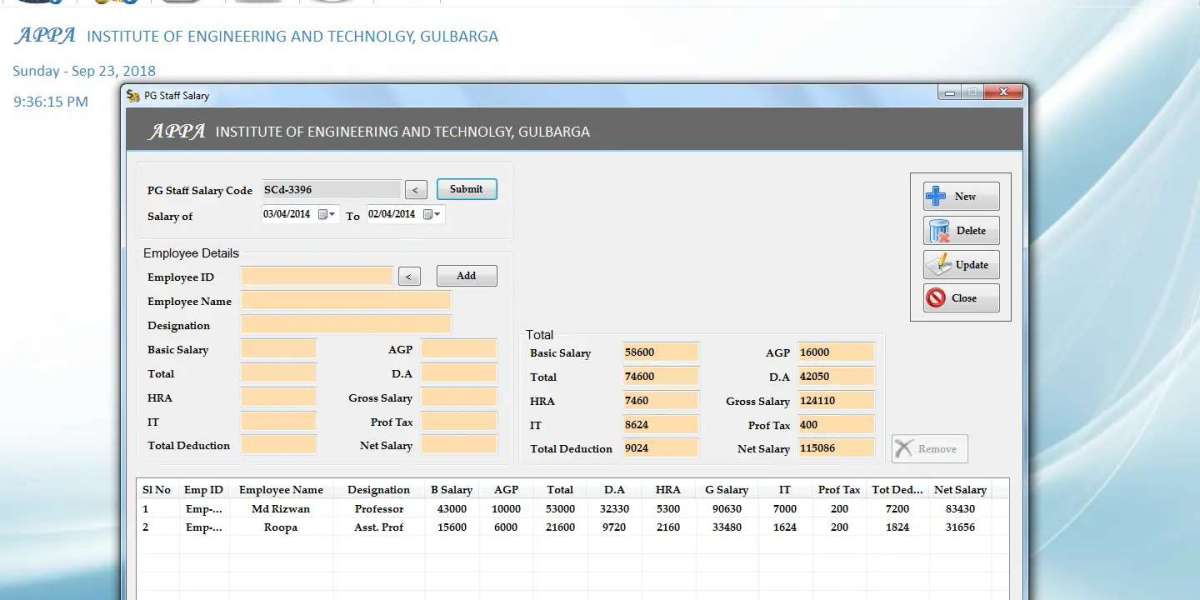In the ever-evolving landscape of human resources (HR) and payroll management, organizations are constantly seeking innovative solutions to streamline processes, enhance efficiency, and ensure accuracy. One such solution that has gained traction in recent years is the Salary Management System (SMS). This sophisticated software tool automates the complex tasks associated with managing employee salaries, benefits, deductions, and incentives, providing organizations with greater control, transparency, and compliance in managing their payroll processes. Let's delve into the intricacies of Salary Management Systems, exploring their evolution, benefits, key features, and best practices for implementation.
Evolution of Salary Management Systems:
The evolution of Salary Management Systems can be traced back to the early days of manual payroll processing, where HR personnel would painstakingly calculate salaries, deductions, and taxes using spreadsheets or paper-based systems. As organizations grew in size and complexity, the need for more efficient and accurate payroll management solutions became apparent.
The advent of computer technology and the internet paved the way for the development of early payroll software applications, which offered basic functionalities such as automated calculations, tax compliance, and reporting. However, these systems were often standalone solutions, lacking integration with other HR functions and business processes.
In recent years, Salary Management Systems have evolved into comprehensive HRIS (Human Resources Information Systems) and HCM (Human Capital Management) platforms, offering a wide range of features beyond payroll processing. These modern systems leverage cloud-based technology, mobile accessibility, and integration with other HR and financial systems to provide organizations with a centralized, scalable, and customizable solution for managing all aspects of employee compensation and benefits.
Benefits of Salary Management Systems:
Salary Management Systems offer numerous benefits for organizations, HR teams, and employees alike:
Efficiency: Automated payroll processes save time and reduce administrative burden, allowing HR teams to focus on strategic initiatives and employee development.
Accuracy: Centralized payroll data and automated calculations minimize errors and ensure compliance with tax laws, labor regulations, and company policies.
Transparency: Employees have access to their salary details, tax deductions, and benefits information through self-service portals, promoting transparency and trust in the payroll process.
Compliance: Salary Management Systems help organizations comply with labor laws, tax regulations, and reporting requirements by enforcing payroll policies consistently and accurately.
Cost Savings: Streamlined payroll processes and reduced manual intervention lead to cost savings in terms of time, resources, and potential penalties for non-compliance.
Employee Satisfaction: Timely and accurate payroll processing, along with easy access to salary information and benefits, enhances employee satisfaction and engagement.
Key Features of Salary Management Systems:
Modern Salary Management Systems offer a comprehensive set of features to meet the diverse needs of organizations:
Automated Payroll Processing: Salary Management Systems automate calculations for salaries, wages, taxes, deductions, and benefits, ensuring accuracy and compliance with regulatory requirements.
Employee Self-Service Portals: Employees can access their salary details, pay stubs, tax forms, and benefits information through self-service portals, reducing reliance on HR personnel and promoting self-management.
Tax Compliance: Salary Management Systems calculate and withhold federal, state, and local taxes based on employee profiles and jurisdictional requirements, generating tax forms and reports for filing purposes.
Benefits Administration: Salary Management Systems manage employee benefits such as health insurance, retirement plans, paid time off, and flexible spending accounts, including enrollment, eligibility, and cost tracking.
Reporting and Analytics: Advanced reporting tools provide insights into payroll costs, trends, and anomalies, enabling HR teams to make data-driven decisions and comply with regulatory reporting requirements.
Integration with Financial Systems: Salary Management Systems integrate with accounting and financial systems to facilitate seamless data exchange, reconciliation, and financial reporting.
Best Practices for Implementing Salary Management Systems:
To maximize the effectiveness of a Salary Management System, organizations should follow these best practices:
Define Clear Payroll Policies: Establish clear and comprehensive payroll policies that outline salary structures, pay schedules, deductions, benefits eligibility, and tax withholding rules.
Customize Configuration: Customize the Salary Management System to align with the organization's unique payroll policies, workflows, and reporting requirements, ensuring it meets specific needs.
Provide Training and Support: Offer training sessions and resources to HR personnel and managers on how to use the Salary Management System effectively, including inputting data, running payroll, and generating reports.
Ensure Data Security: Implement robust security measures to protect sensitive payroll data stored in the system, including encryption, access controls, and regular security audits.
Conduct Regular Audits: Regularly audit payroll data, processes, and reports to identify errors, discrepancies, and compliance risks, ensuring accuracy and integrity in payroll management.
Stay Updated on Regulations: Stay informed about changes in tax laws, labor regulations, and reporting requirements that may impact payroll processing, and update the system accordingly to ensure compliance.
Conclusion:
In conclusion, Salary Management Systems play a vital role in modernizing and optimizing payroll processes for organizations of all sizes. By leveraging automation, self-service capabilities, and advanced analytics, these systems empower organizations to streamline payroll processing, ensure compliance, and enhance employee satisfaction. As organizations continue to embrace digital transformation, Salary Management Systems will remain essential tools for managing employee compensation and benefits effectively in today's dynamic business environment.







